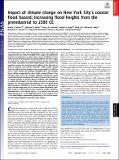Impact of climate change on New York City’s coastal flood hazard: Increasing flood heights from the preindustrial to 2300 CE
Author(s)
Garner, Andra J.; Mann, Michael E.; Kopp, Robert E.; Lin, Ning; Alley, Richard B.; Horton, Benjamin P.; DeConto, Robert M.; Donnelly, Jeffrey P.; Pollard, David; Emanuel, Kerry Andrew; ... Show more Show less
Download11861.full.pdf (2.408Mb)
PUBLISHER_POLICY
Publisher Policy
Article is made available in accordance with the publisher's policy and may be subject to US copyright law. Please refer to the publisher's site for terms of use.
Terms of use
Metadata
Show full item recordAbstract
The flood hazard in New York City depends on both storm surges and rising sea levels. We combine modeled storm surges with probabilistic sea-level rise projections to assess future coastal inundation in New York City from the preindustrial era through 2300 CE. The storm surges are derived from large sets of synthetic tropical cyclones, downscaled from RCP8.5 simulations from three CMIP5 models. The sea-level rise projections account for potential partial collapse of the Antarctic ice sheet in assessing future coastal inundation. CMIP5 models indicate that there will be minimal change in storm-surge heights from 2010 to 2100 or 2300, because the predicted strengthening of the strongest storms will be compensated by storm tracks moving offshore at the latitude of New York City. However, projected sea-level rise causes overall flood heights associated with tropical cyclones in New York City in coming centuries to increase greatly compared with preindustrial or modern flood heights. For the various sea-level rise scenarios we consider, the 1-in-500-y flood event increases from 3.4 m above mean tidal level during 1970–2005 to 4.0–5.1 m above mean tidal level by 2080–2100 and ranges from 5.0–15.4 m above mean tidal level by 2280–2300. Further, we find that the return period of a 2.25-m flood has decreased from ~500 y before 1800 to ~25 y during 1970–2005 and further decreases to ~5 y by 2030–2045 in 95% of our simulations. The 2.25-m flood height is permanently exceeded by 2280–2300 for scenarios that include Antarctica’s potential partial collapse. Keywords: tropical cyclones; flood height; New York City; sea-level rise; coastal flooding
Date issued
2017-10Department
Massachusetts Institute of Technology. Department of Earth, Atmospheric, and Planetary SciencesJournal
Proceedings of the National Academy of Sciences
Publisher
National Academy of Sciences (U.S.)
Citation
Garner, Andra J. et al. “Impact of Climate Change on New York City’s Coastal Flood Hazard: Increasing Flood Heights from the Preindustrial to 2300 CE.” Proceedings of the National Academy of Sciences 114, 45 (October 2017): 11861–11866 © 2017 National Academy of Sciences
Version: Final published version
ISSN
0027-8424
1091-6490